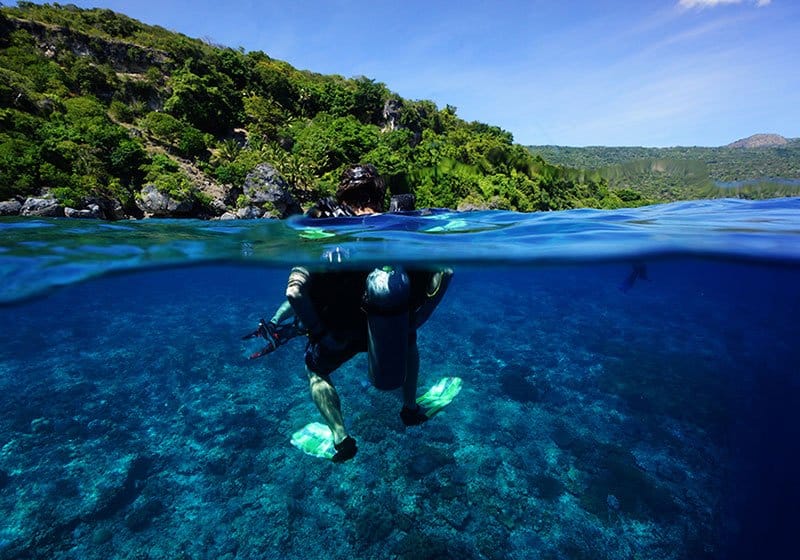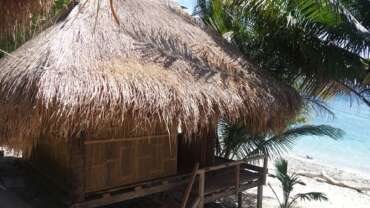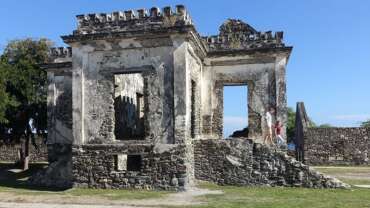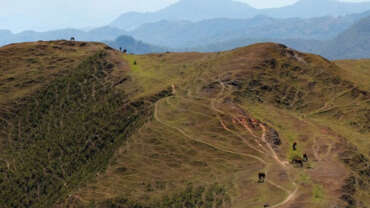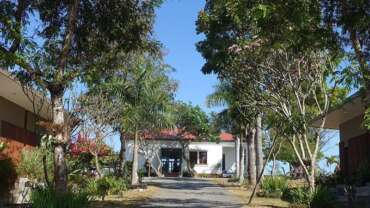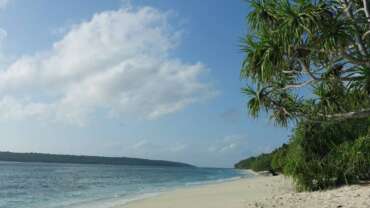Adventure Tourism in Timor Leste
HIKING & WALKING
Timor-Leste is the perfect place for hiking. The country has stunning scenery, friendly locals and a network of tracks criss-crossing the entire country. From coastal walks to multi-day village and mountain hikes, Timor-Leste has some excellent options.
Some of the most rewarding and excellent hikes in Timor are:
Mt Ramelau: Timor-Leste’s highest mountain with 2963mt and the roof of Central Timor, Mt. Ramelau (is a must if you are a hike-lover. Watching the sun rise over Timor-Leste from the summit is a sight not to be missed. The hike is a three-hours steady ascent from the mountainous village of Hato Builico (at 1900 mts). It is recommended to hire a local guide to do the hike, which can be combined to a visit to the surrounding hills and also neighboring remote ethnic villages and sacred sites.
This mountain also plays an important role in Timorese culture and cult, and the top is marked with 3m-high statue of the Virgin Mary. Timorese from all over the country come here every year on 7 October to thank god and have happy thoughts.
Further south, Mt. Kablaki is one of the most unspoilt and hardly explored peaks of Timor Leste and even though infrastructure is not fully in place, yet this would be an interesting hike for an adventure seeker.
Matebian mountains: This range is formed by limestone and is located about 20 kilometers south-east of Baucau. Although lower than those in the Ramelau area, the climb here is longer to the 2377 mt summit of Matebean Mane, the largest and southernmost of the two Matebean Mountains. These mountains are the birthplace of rivers that flow to the south and north coast, and possibly the most rugged high mountains in Timor. The name means “Mountain of the death” and this was one of the last holdouts of the Fretilin forces during the Indonesian occupation wave of 1978.
The trekking is medium to hard and could be done as a two or three-day walk, or separate one-day walks with an overnight stay in the high mountain villages of Afaloeki, Ossuna or Quelicai. The later one is the base of a pilgrimage route to the mountain that is popularly followed in August and October.
Mundo Perdido: Mundo Perdido (1775m) – which translates to ‘Lost World’ – is another of the country’s highlights. The peak cuts Baucau and Viqueque regions and the start of the trail is located bet between the villages of Loi Huno and Ossu. The area of Mundo Perdido is one of the largest rainforests in the country, and the territory is also home of multiple bird and mammal species.
The ascent to Mundo Perdido is a demanding trek, which takes around 4-5 hours up and down, and you will need to hire a guide to accompany you.
Horta Loop: The ‘Horta Loop’ is a 2-3 hours circuit located just in the outskirts of Dili. It goes from Areia Branca beach (starting point at the back of Jose Ramos-Horta expresident residence) and includes the Back Beach and coastal views from the Cristo Rei statue a top Cape Fatucama.
Oucusse: Very few travelers visit this tranquil Timorese enclave, called Oecussi Ambeno, which is an overnight ferry trip west of Dili. Situated on the north coast, all of land borders are Indonesia West Timor. It is 27,000 square kilometers in area, with a population of almost 50,000 people.
There are vast hiking areas to explore in this enclave, including caves. The mountains here are extremely abrupt and are made up of a cemented conglomerate rock in various stages of weathering and hiking in the area requires some more professional hiking equipment. Mt Manoleu and Mt. Sapo are the highest mountain in this region with over 1,200 meters. The village of Kutet, situated three hours walk up over a saddle to the south of Oecussi town, nestles under the main mountain peaks, making it an excellent base to explore the mountains, climb to the peaks, scale some of the rock faces or explore the caves.
Atauro: The mountainous tropical island of Atauro, situated thirty kilometers north of Dili in the Wetar strait, is 24 kilometers long by 10 kilometers wide. It has a population of 8000 people who mostly live in two villages on the island;s eastern side. There are only few motor vehicles in the island making from it a great place for hiking and wildlife exploration.
Atauro mountainous lays across the entire island and its highest point is Mt. Manucoco, with 995 mt. It is possible to climb the mountain starting at Villa. There are also some mountainous villages that can be visited during the trek, which are famous for their handicrafts.
MOUNTAIN BIKING
Timor-Leste’s compact size, scenic diversity and relatively light traffic mean mountain biking is an interesting and fun way to explore the country. That said, if you head inland, hills are extremely rugged and some of the steeper sections are brutal. Mountain biking in Timor-Leste is definitely not for the faint hearted.
While a few places hire bikes in Dili and on Atauro for day use, basic mountain bikes can be purchased in Dili for around USD300. If you are an enthusiast, it is definitely recommended you bring your own gear.
Some of the highlights for mountain biking in the country are in the eastern regions of Baucau, Los Palos and on to Jaco island, and the roads are a mix of quality roads together with gravel and mountain-bike treks.
FISHING
The ocean around Timor-Leste provides excellent fishing opportunities. Local people are adept with net, spear and trap. Arrange to go out with Timorese fishers in their colourful wooden craft for inshore fishing or charter a larger tourism boat and head for the deep.
Potential big game fish that ply Timorese waters include giant trevally, yellow fin tuna, Spanish mackerel, sailfish and marlin. One of the joys of travelling in Timor-Leste definitely is eating freshly caught barbecued fish (with a squeeze of fresh lime juice).
SNORKELLING
Snorkelling is a must do when visiting Timor-Leste – it is a truly wonderful experience whether you have snorkelled before or it is your first time. Atauro and Jaco Islands are the most popular snorkelling locations due to the clarity of their warm tropical water and rich marine life.
In close proximity to Dili, along the very scenic northern coast, there are other great sites, usually requiring a short boat ride or swim from the beach. The incredible variety of coral and fish species is quite overwhelming.
Timor-Leste lies at the southwest corner of the famous Coral Triangle. This contains nearly 600 different species of reef building corals and more than 2,000 reef fish species. While some dive companies and accommodation places rent snorkel gear it is recommended that you bring your own set if feasible.
BIRDING
Of vital interest to bird watchers is Timor-Leste’s bio-geographically mixed bird life (Asian and Australian). There are more than 240 bird species, including at least 23 found nowhere else in the world. The very high diversity of bird species reflects Timor-Leste’s extremely wide range of habitats and geographic location.
These unique bird species include relatively abundant numbers of the globally threatened Timor green pigeon, Timor imperial pigeon, yellow crested cockatoo, black cuckoo dove and the Timor sparrow.
Come and be surprised.
DIVING
Located within the famous Coral Triangle, Timor-Leste has some of the most pristine, ecologically diverse and least explored dive sites on the globe. The marine life is abundant with colourful hard and soft corals as well as a vivid array of reef fish.
Open water species such as tuna and mackerel are encountered along with harmless reef and whale sharks, manta rays, turtles and the more elusive dugongs. In more sheltered sites you’ll marvel at the variety of fascinating smaller critters – displaying weird and wonderful shapes and colours.
Reefs run close to the shore along much of Timor-Leste’s northern coast, immediately in front of the capital Dili and around Atauro and Jaco Islands. Sites range from more sheltered and gently sloping fringing reefs to magnificent wall diving with underwater cliffs plunging into the abyss. Most of the best dive sites are very accessible – some requiring just a short swim from the beach. Warm tropical waters provide excellent visibility all year around.
The availability of experienced diving companies makes Timor-Leste an epic dive location whether you are a novice or veteran. Local diving companies provide shore and boat dives, PADI courses and overnight dive safaris. Shore dives are offered in close proximity to Dili, at dive sites to the west and east along the northern coast.
Atauro Island is another very popular destination for guided diving adventures from Dili and all companies run their own boats. Atauro Dive Resort is located at Beloi on Atauro and Compass Diving has Eco-Camp at Beloi.



